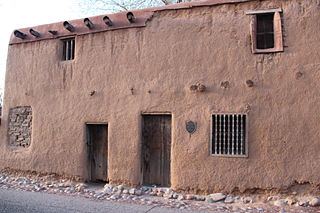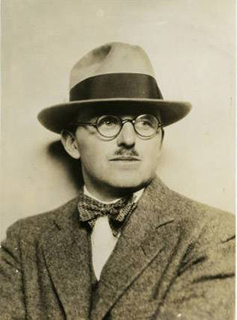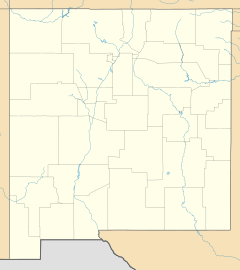
Hotel Andaluz is a historic high-rise hotel in Downtown Albuquerque, New Mexico. It opened in 1939 as the Hilton Hotel, part of the Hilton Hotels chain. After operating under various names since the 1970s, the hotel was renovated and reopened under its current name in 2009. In 2019 it joined the Curio Collection by Hilton brand.

The De Vargas Street House, often referred to as the Oldest House, is a historic building in Santa Fe, New Mexico, which is often said to be one of the oldest buildings in United States. The original date of construction is unknown but the majority of the building is believed to date to the Spanish colonial period (post-1610). One archaeological study also concluded that some sections of the walls are characteristic of Pueblo architecture and may be pre-Spanish in origin. The building was listed on the National Register of Historic Places and New Mexico State Register of Cultural Properties in 1968 as a contributing property in the Barrio De Analco Historic District.

Old Town is the historic original town site of Albuquerque, New Mexico, for the provincial kingdom of Santa Fe de Nuevo México, established in 1706 by New Mexico governor Francisco Cuervo y Valdés. It is listed on the New Mexico State Register of Cultural Properties as the Old Albuquerque Historic District, and is protected by a special historic zoning designation by the city. The present-day district contains about ten blocks of historic adobe buildings surrounding Old Town Plaza. On the plaza's north side stands San Felipe de Neri Church, a Spanish colonial church constructed in 1793.

Taos Plaza is a center of shops and monuments within the Taos Downtown Historic District in Taos, New Mexico.

Lamy station is an Amtrak station at Santa Fe County Road 33, 152 Old Lamy Trail in Lamy, New Mexico, United States. It is served by the Southwest Chief. Until 2014, it was the southern terminus for the Santa Fe Southern Railway. The station was built in 1909 by the Atchison, Topeka and Santa Fe Railway.

John Gaw Meem IV was an American architect based in Santa Fe, New Mexico. He is best known for his instrumental role in the development and popularization of the Pueblo Revival Style and as a proponent of architectural Regionalism in the face of international modernism. Meem is regarded as one of the most important and influential architects to have worked in New Mexico.

The Pueblo Revival style or Santa Fe style is a regional architectural style of the Southwestern United States, which draws its inspiration from Santa Fe de Nuevo México's traditional Pueblo architecture, the Spanish missions, and Territorial Style. The style developed at the beginning of the 20th century and reached its greatest popularity in the 1920s and 1930s, though it is still commonly used for new buildings. Pueblo style architecture is most prevalent in the state of New Mexico, it is often blended with the Territorial Revival architecture.

The Santa Fe Plaza is a National Historic Landmark in downtown Santa Fe, New Mexico in the style of traditional Spanish-American colonial cities. The plaza, or city square, was originally, and is still to this day, the center gathering place in town. Many know it as "the heart of Santa Fe". The landmark has since grown into a playground for many tourists interested in Spanish, Native American, and Mexican cultures, and includes music, design, jewelry, art and dance. It is home to annual events including Fiestas de Santa Fe, the Spanish Market, the Santa Fe Bandstand, and the Santa Fe Indian Market.

The Mission Revival style was an architectural movement that began in the late 19th century for a colonial style's revivalism and reinterpretation, which drew inspiration from the late 18th and early 19th century Spanish missions in California. It is sometimes termed California Mission Revival, particularly when used elsewhere, such as in New Mexico and Texas which have their own unique regional architectural styles.

The El Rey Court is located at 1862 Cerrillos Road in Santa Fe, New Mexico. This campus spans 5 acres and is located near what used to be Route 66. The property includes traditional adobe style buildings surrounded by gardens.
The following is a timeline of the history of the city of Albuquerque, New Mexico, US.

La Fonda on the Plaza is a historical luxury hotel, located at 100 E. San Francisco Street and Old Santa Fe Trail in downtown Santa Fe, New Mexico adjacent to the Plaza. La Fonda simply means "the inn" in Spanish, but the hotel has been described as "the grand dame of Santa Fe's hotels."
The history of Albuquerque, New Mexico dates back up to 12,000 years, beginning with the presence of Paleo-Indian hunter-gatherers in the region. Gradually, these nomadic people adopted a more settled, agricultural lifestyle and began to build multi-story stone or adobe dwellings now known as pueblos by 750 CE. The Albuquerque area was settled by the Tiwa people beginning around 1250. By the 1500s, there were around 20 Tiwa pueblos along a 60-mile (97 km) stretch of the middle Rio Grande valley. The region was visited by Spanish conquistadores beginning with the expedition of Francisco Vázquez de Coronado in 1540–41, and began to be settled by Spanish colonists after the expedition of Juan de Oñate in 1598. By 1680, 17 Spanish estancias were reported along the Camino Real in the Albuquerque area.

Scholes Hall is the historic administration building of the University of New Mexico, located on the main campus in Albuquerque. It was the first of many buildings designed for the university by Santa Fe architect John Gaw Meem, who helped to cement the Pueblo Revival style as the "official" architecture of the campus. Built in 1934–36 with Public Works Administration funding, it is regarded as one of Meem's most notable designs.

Historic Hotels of America is a program of the National Trust for Historic Preservation that was founded in 1989 with 32 charter members; the program accepts nominations and identifies hotels that have maintained their authenticity, sense of place, and architectural integrity. As of June 5, 2015, the program included over 260 members in 44 states, including the District of Columbia, Puerto Rico, and the U.S. Virgin Islands.

La Posada de Santa Fe, formerly known as La Posada Inn, is a hotel in Santa Fe, New Mexico that dates back to a mansion built in 1882.

A special election to determine the member of the United States House of Representatives for New Mexico's 3rd congressional district was held on May 13, 1997. Republican Bill Redmond defeated Democrat Eric Serna in a result which flipped this heavily Democratic seat to the Republican column. Redmond replaced Bill Richardson, who resigned from his seat in the House after he was appointed by Bill Clinton to be the United States Ambassador to the United Nations.

The Alvarado Hotel was a historic railroad hotel which was one of the most famous landmarks of Albuquerque, New Mexico. It was built in 1901–02 by the Atchison, Topeka and Santa Fe Railway and was operated by the Fred Harvey Company until 1970. With 120 guest rooms, it was the largest of all the Harvey hotels. Its demolition by the railroad in 1970 was described by preservationist Susan Dewitt as "the most serious loss of a landmark the city has sustained" and helped mobilize stronger support for historic preservation efforts in the city.

The Castañeda Hotel is a historic railroad hotel located in Las Vegas, New Mexico. It was built in 1898 and 1899 by the Atchison, Topeka and Santa Fe Railway, and was operated by the Fred Harvey Company until 1948. After being mostly vacant for many years, the hotel was restored and reopened in 2019. The Castañeda was listed on the New Mexico State Register of Cultural Properties in 1974 and the National Register of Historic Places in 1979 as a contributing property in the Railroad Avenue Historic District. It is located adjacent to the Las Vegas railroad station.

















